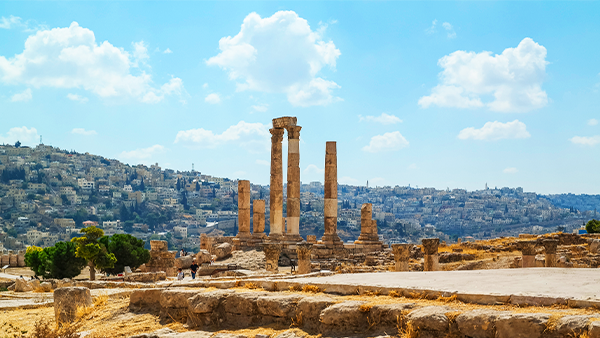History
Jordan is the cradle of civilizations. The oldest discoveries in Jordan, according to archaeologists, date back to about 1.5 million years ago. Many civilizations have been in Jordan from the Stone Ages to the late Islamic periods, including Persian, Greek, Roman, and Byzantine Ages.
These civilizations left immortal evidences: architectural buildings such as theaters, temples, churches, mosques, palaces, and castles, arts and cultural objects such as statues, inscriptions, mosaics, and writings, techniques of dealing with water, agriculture, industry, and habitation.
Several kingdoms were established on the land of Jordan, including the Moabites, the Edomites, the Ammonites, and the Kingdom of the Nabataeans, whose architectural buildings stand as a living model witness to the greatness of that civilization.
Many Roman Cities (The Decapolis) were in Jordan such as Jarash, Amman, Pella, Abilla and more….
Jordan land witnessed many important battles in the early Islam such as Battles of Yarmouk, Tabqat Fahl, and Mutah.
The Jordanian Badia was a haven for the northern Arab tribes, as their inscriptions, which are rich in the Badia, revealed their civilizational communication with neighboring countries and tribes.
The Capital of Jordan

Amman is the capital of the Kingdom, and its commercial, administrative, economic and educational center. It is the center of the most populous governorate, and the third largest in area.
Natural factors played a key role in Amman's prosperity and its choice as the capital of the country, as it was a city of springs, and mediated a number of fertile agricultural plains.
The capital rises at an average of 750m above sea level, and has its own distinctive characteristics in the site and contemporary architecture, which made it a magnet for many visitors and tourists.
Geography
Location and Area
Jordan is characterized by a strategic geographic location as it lies between latitudes 29’11” and 33’22” North, and longitudes 34’59” and 39’12” East.
It is bordered by Syria to the north with 375km, Iraq to the northeast with 181km, the Kingdom of Saudi Arabia to the south and southeast with 744km, and Palestine to the west with 335km.
The total length of Jordan's land borders is about 1,635km, while the length of its maritime borders is about 26km, and the total area of Jordan is approximately 89,342km2, Land covers an area of 88,802km2, while water covers an area of 540km2.
Climate
Jordan has a diverse climate, between the Mediterranean climate in the center and the highlands, and the dry desert climate in the Badia region. The temperature variations in the country generally range between zero degrees Celsius in winter and 40 degrees Celsius in summer, and annual rainfall amounts between 800 mm in the mountains, and 50 mm in the desert.
Jordan is divided climatically and geographically into three main regions:
al-Aghwar (Jordan Valley)
It extends along the western border and includes the Jordan River Valley in the north, the Dead Sea in the center and Wadi Arabah and the Gulf of Aqabah in the south, and is part of the Great Rift Valley between Asia and Africa.
The Dead Sea is the lowest point below sea level on the planet Earth. The Gulf of Aqaba is Jordan's only access to the sea.
Mountain heights
It extends from Umm Qays in the north to Ras al-Naqab in the south, and it separates al-Aghwar (Jordan Valley) in the west and the flat desert in the east. This area has good amounts of rainfall during the year, making it the center of the country's habitation.
Eastern Desert
It occupies 75% of the area of the Kingdom, and has its natural extension in Syria, Iraq, and the Kingdom of Saudi Arabia; it has a dry and hot desert climate. It is divided into the Northern Badiah and the Southern Badiah.
Population
The population of Jordan in 2021 was estimated at about 11,057,000 people, thus occupying the 88th place among the countries of the world in terms of the population, which constitutes approximately 0.13% of the total population of the world, and accordingly the population density in it is about 124.5 person per square kilometer.
Most of the population is concentrated in the center and north, where the climate is temperate.
While the Arabs constitute the vast majority of the population along with other minorities such as Circassians, Chechens, Kurds, Armenians, and Druze.
Tourism in Jordan
The tourism sector in Jordan is an effective tool in providing and raising the national income by supporting and developing other economic sectors, which consequent in increasing work opportunities and improving the standard of living.
On other side, it has become an important source of development and intellectual renaissance in Jordan society, in addition to the social, cultural and environmental effects which became as fact by contacting between local people and many groups of tourists with different languages, cultures, customs and beliefs.
Tourism has a big role as an effective tool for showing the true image of Jordan at the international level.